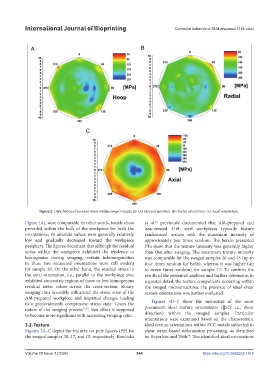Page 352 - IJB-10-1
P. 352
International Journal of Bioprinting Corrosion behavior of SLM-prepared 316L steel
Figure 2. Distribution of residual stress within swaged sample 20. (A) Hoop orientation. (B) Radial orientation. (C) Axial orientation.
Figure 1A), were comparable. In other words, tensile stress et al. previously documented that AM-prepared and
16
prevailed within the bulk of the workpiece for both the heat-treated 316L steel workpieces typically feature
orientations; its absolute values were generally relatively randomized texture with the maximum intensity of
low and gradually decreased toward the workpiece approximately two times random. The herein presented
periphery. The figures document that although the residual PFs show that the texture intensity was generally higher
stress within the workpiece exhibited the tendency to than that after swaging. The maximum texture intensity
homogenize during swaging, certain inhomogeneities was comparable for the swaged samples 20 and 15 (up to
in these two measured orientations were still evident four times random for both), whereas it was higher (up
for sample 20. On the other hand, the residual stress in to seven times random) for sample 17. To confirm the
the axial orientation, i.e., parallel to the workpiece axis, results of the presented analyses and further determine, in
exhibited concentric regions of more or less homogenous a greater detail, the texture components occurring within
residual stress values across the cross-section. Rotary the swaged microstructures, the presence of ideal shear
swaging thus favorably influenced the stress state of the texture orientations was further evaluated.
AM-prepared workpiece and imparted changes leading
to a predominantly compressive stress state. Given the Figures 3D–F show the intensities of the most
nature of the swaging process 16,49 , this effect is supposed prominent ideal texture orientations (||SD, i.e., shear
to become more significant with increasing swaging ratio. direction) within the swaged samples. Particular
orientations were examined based on the characteristic
3.2. Texture ideal texture orientations within FCC metals subjected to
Figures 3A–C depict the textures via pole figures (PF) for shear strain-based deformation processing, as identified
74
the swaged samples 20, 17, and 15, respectively. Kunčická by Beyerlein and Tóth . The identified ideal orientations
Volume 10 Issue 1 (2024) 344 https://doi.org/10.36922/ijb.1416

